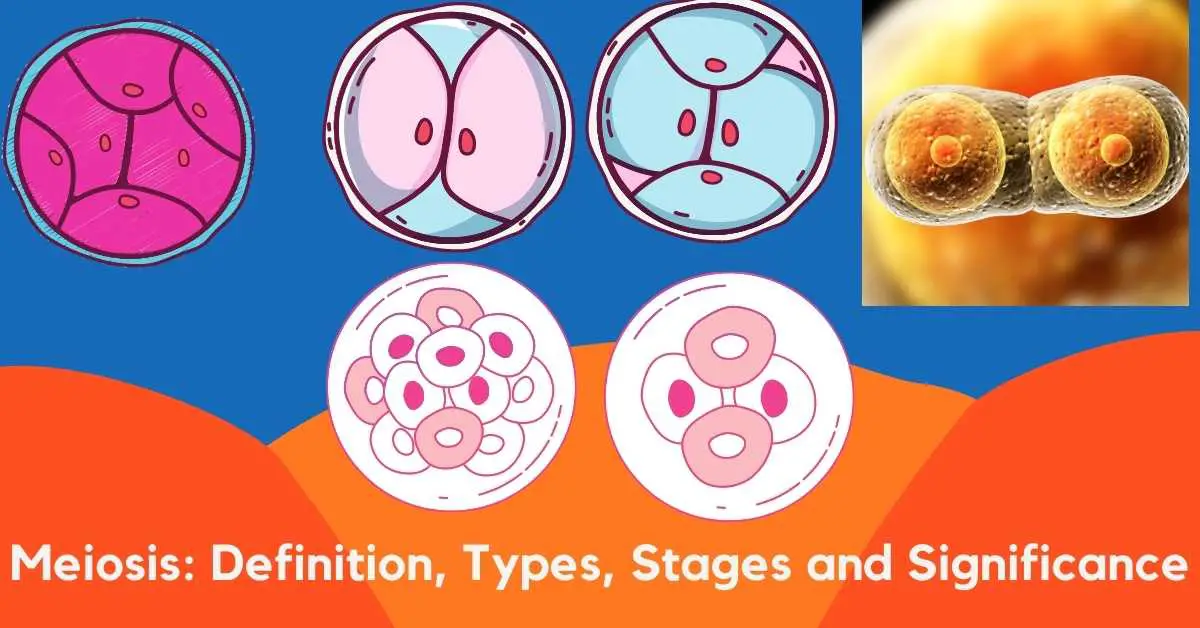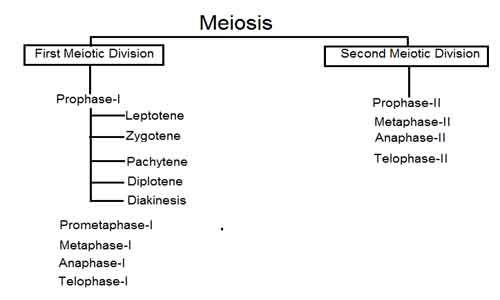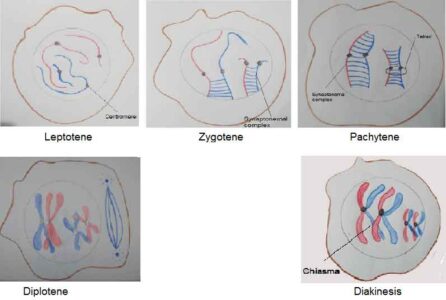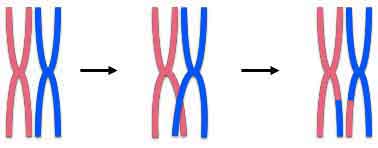Dividing cell is one of the important events in our life which divide each day, each hour, each seconds. In this process, a single cell divides to form two cells and again two cells produce four cells and so on. This process is known as cell division or cell reproduction. Cell division is of three types: amitosis, mitosis and meiosis.
The cells of the particular species have a constant number of chromosomes. For example, human contains 46 or 23 pairs chromosomes (44+XY in male and 44+XX in female). In sexually reproducing organism`s male and female gametes fuse together to form the zygote. If the gamete has the same number (46) of chromosomes as the somatic cells then the zygote would have twice (92) the diploid number of chromosomes. This number would go on doubling with each generation. However, the chromosome number always remains constant from generation to generation i.e., 46. This is due to meiotic division which reduces the chromosomes number to half and counteracts the effect of fertilization.
The procedure happening during gamete or spore formation and involving a reduction division whereby every daughter cell gets one of each pair of chromosomes, thus lessening the number of chromosomes in every cell to one half is known as meiosis. It is also called a reduction division. German biologist Oscar Hertwig first time described the meiosis in sea urchin eggs in 1876. But Belgian zoologist Edouard Van Beneden again described the meiosis in Ascaris (roundworm) eggs at the chromosome level
During the meiosis process, division of chromosome occurs one time while the division of nucleus and cytoplasm occur two times. Due to the meiosis, four haploid cells are formed from the single diploid cell. A cell undergoing meiosis is sometimes called meiocytes.
Types of Meiosis
There are three types of meiosis occurs in different organisms:
- 1. Terminal or gametic meiosis (diplotonic pattern)
- 2. Intermediary or Sporic Meiosis(deplohaplotonic pattern)
- 3. Initial or Zygotic Meiosis (Haplotonic Pattern)
Terminal or gametic meiosis (diplotonic pattern): This type of meiosis is found in animals and in a few lower plants. It occurs just before the formation of gametes. The gametes are produced in gonads like testis and ovaries by the process called spermatogenesis and oogenesis, respectively.
Intermediary or Sporic Meiosis (deplohaplotonic pattern): It is the characteristic of higher plants and some thalophytes but is not found in animals. It takes place sometime between fertilization and the formation of gametes. In such cases, meiosis is followed by mitosis producing large number of gametes. It also produces microspores (in anthers) and megaspores (in ovaries).
Initial or Zygotic Meiosis (Haplotonic Pattern): It is found in some algae, fungi and diatoms. Fertilization is immediately followed by mitosis giving rise to cells with the haploid chromosome number. The zygote is the only diploid stage in the life cycle.
You might also read: Mitosis and Its Significance
Steps of Meiosis
The successive meiotic division can be divided into the following two types:
The First Meiotic Division
Meiosis starts after an intermeiotic interphase. In this division, the diploid (2n) number of chromosomes reduces to haploid (n) number chromosomes.
Interphase: Interval between eukaryotic cell division in which growth and synthetic activities take place. The interphase prior meiosis is important because replication of DNA takes place during this stage.
Prophase-I:
It is the most important and longest stage closely similar to the early mitotic prophase. It is divided into the following sub-stages:
- Lepotene
- Zygotene
- Pachytene
- Diplotene and
- Diakinesis
Leptotene: The stage of meiosis in which the chromosomes condense and become visible is known as leptotene or leptonema. The chromosomes become more visible. Hence it is the first step of meiosis. In this stage, the following characteristic features take place:
- The cells and their nuclei are generally larger than those of the surrounding tissues.
- The chromosomes are duplicated. In this case, chromosome with two chromatids look single.
- Under light microscope chromosomes show bead-like thickening called chromomeres, occurring at irregular intervals along their length.
- Leptomeric chromomeres may show a definite polarization forming loops in which the telomere is attached to the nuclear envelope at a region pointing towards the centrioles. This arrangement is often called a bouquet.
- In the plant cells, the chromosomes may sometimes form a tangle of threads called the synaptic knot, on one side of the nucleus.
- In the animal cell, the centrosome divides and goes to opposite poles.
Zygotene: The stage of meiosis in which the homologous chromosomes form pairs with each other is known as a zygote. The important characteristic features of zygotene are:
- Movement of chromosomes initiates the zygote stage and this movement results from an attractive force that brings homologous chromosomes together.
- The chromosomes become shorter and thicker.
- The lengthwise pairing of homologous chromosomes begins.
- Homologous chromosomes originate one from the male parent (paternal chromosome) and the other from the female parent (maternal chromosome). They are attracted to each other and their pairing takes place. This pairing is known as synapsis. This pairing takes place throughout its length.
- Pairing takes place not only between homologous chromosomes but also between homologous regions of the chromosomes.
- During synapsis, a special proteinacious structure called the synaptonemal complex is formed. It is present in the space formed between two homologous chromosomes.
- The nucleolus is visible.
Pachytene: The stage of meiosis in which two chromatids belonging to different homologues exchange segments of genetic material between them is called pachytene. The important characteristics features of this stage are:
- The chromosomes are still going shorter and thicker by coiling.
- Each chromosome is now a bivalent or tetrad (bivalent or tetrad is a pair of homologous consisting of four chromatids. The two chromatids of each homologue are called sister chromatids united by centromere).
- The characteristic phenomenon is the exchange of segments; that is the recombination of chromosomal segments between two chromatids belonging to different homologues.
- Two chromatids belonging to different homologues undergo one or more transverse breaks at the same level. The break is followed by interchange and fusion of broken ends between two homologous chromosomes. This is known as crossing over. Crossing over is the process which involves ensuing redistribution and mutual exchange of hereditary material of two parents between two homologous chromosomes.
- The nucleolus remains prominent and is found to be associated with the nucleolar organizer region of the chromosome.
Diplotene: The stage of meiosis in which paired homologues begin to separate is known as diplotene. The characteristic features of diplotene are:
- The homologous chromosomes repel each other due to the decrease of the force of attraction between them.
- The separating chromosomes are held together at one or more points in which break and fusion occurred. These points are known as chiasmata. (Chiasmata: The point of chromosomal interchange that becomes visible when the homologues begin to separate at diplotene is known as chiasmata. The number of chiasma(plural) may be one, two or several depending on the length of chromosomes)
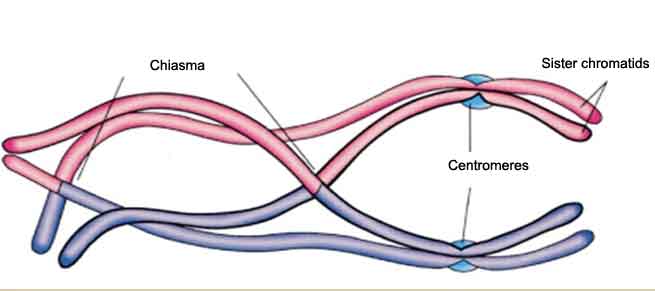
Diakinesis: The stage of meiosis during which chromosome contraction increases at the end of this stage the homologues are attached only at the chiasmata. The characteristic features of diakinesis are:
- The chromosomes have become shorter and thicker as the two bivalents move further away from each other. The homologues remain in contact with each other by their terminal chiasmata. This process is called terminalization.
- The nucleolus is detached from the chromosome or disappears.
Prometaphase-I:
The characteristic features of prometaphase are:
- The nuclear envelope disappears.
- The microtubules get arranged in the form of the spindle in between the two centrioles which occupy the position of two opposite poles of the cell.
- The chromosomes form greatly coiled in spiral manners and get arranged on the equator of the spindle.
Metaphase-I:
The characteristic features of metaphase-I are:
- The microtubules of the spindle are attached with the centromeres of the homologous chromosomes of each tetrad.
- Each chromosome contains centromere which is directed towards the opposite poles.
- The repulsive forces between homologous chromosomes increase greatly and the chromosomes become ready to separate.
Anaphase-I:
The characteristic features of anaphase-I are:
- The homologous chromosomes, each consisting of two chromatids united by a centromere, move towards the opposite poles of the cell.
- The chromosomes do not separate simultaneously. The short chromosome separates quickly while the separation of long chromosomes is delayed.
- Unlike mitotic anaphase, in which the chromosomes appear longitudinally single, each chromosome now consists of two distinctly separated chromatids united only at their centromeres.
- The actual reduction occurs at this stage. The homologous chromosomes that move towards the opposite poles are the chromosomes of either parental or maternal origin.
Telophase-I:
The characteristic features are the following:
- Nuclear envelope is formed by the endoplasmic reticulum(ER) around the chromosomes.
- The chromosomes undergo deserialization and become elongated.
- Nucleoli do not reappear and spindle fibers do not disappear.
Cytokinesis:
In the plant cells: There is a formation of a cell plate between the two groups of chromosomes and thus two daughter cells are formed.
In animal cells: The cell membrane constricts and two daughter cells are formed. The daughter cells thus produced contain a haploid number (n) of chromosomes.
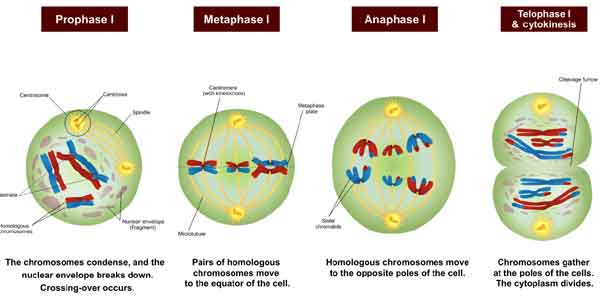
The Second Meiotic Division
It is essentially similar to the mitotic division which divides each haploid meiotic cell into two haploid cells i.e., a number of chromosomes (n) remain the same. The second meiotic division includes the following four stages:
Prophase-II
The characteristic features of prophase-II are:
- Each centriole divides into two and forms two centrioles.
- Spindle formation takes place.
- The nuclear membrane begins to disappear.
- Each chromosome is made up of two chromatids. The chromatids have widely separated arms.
Metaphase-II
The characteristic features of metaphase-II are:
- The chromosomes get arranged on the equator of the spindle.
- The spindle fibers are attached to the centromere of the chromosomes.
Anaphase-II
The characteristic features of Anaphase-II are:
- The centromere divides into two and thus each chromosome produces two daughter chromosomes called monads.
- The daughter chromosomes (chromatids) separate out and move towards the opposite poles.
Telophase-II
The characteristic features of Telophase-II are:
- The chromatids migrate to the opposite poles are now known as a chromosome.
- The reappearance of the nuclear membrane and nucleolus takes place.
- Chromosomes disappear due to the hydration of the nucleus.
After the karyokinesis in each haploid meiotic cell, the cytokinesis occurs and thus four haploid cells are produced, These cells may have chromosomes with different genetic combinations due to the crossing over in the prophase-I.
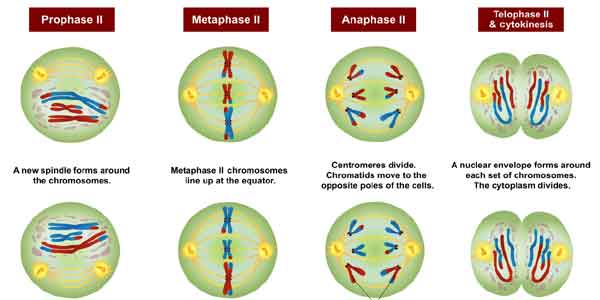
Significance of Meiosis
- Meiosis maintains a definite and constant number of chromosomes in the cell of a particular species.
- In the animal kingdom. Meiosis leads to the formation of sexual gametes, the eggs (ovum) and the sperm.
- In the plant kingdom, meiosis occurs at various times during the life cycle (the haploid products may be sexual gametes or asexual spores).
- Through crossing over, meiosis provides an opportunity for the exchange of the genes and thus it causes the genetic variation among the species.
- Meiosis is regulated as a compensatory mechanism opposite to syngamy or fertilization.
Difference Between Mitosis and Meiosis
|
Mitosis |
Meiosis |
|---|---|
|
Mitosis occurs in all somatic cells. |
Meiosis occurs in germ cells. |
|
Cell divides only once at a time. |
Cell divides twice at a time. |
|
Chromosome number remains unchanged after division. |
Chromosome number reduced to half after division. |
|
Two haploid cells are formed from a single diploid cell. |
Four haploid cells are formed from a singles diploid cell. |
|
Interphase following mitosis is of longer duration. |
Interphase following meiosis is comparatively shorter duration. |
|
DNA synthesis takes place in interphase. |
DNA synthesis extends up to prophase-I. |
|
Prophase: The duration of prophase is short. |
The duration of prophase is longer. |
|
In this case, comparatively simple prophase stage occurs. |
In this case, prophase stage is complicated and it includes various divisions such as leptotene, zygotene, pachytene, diplotene and diakinasis, etc. |
|
No pairing or synapsis takes place between homologous chromosomes. |
Pairing or synapsis occurs between the homologous chromosomes. |
|
At the beginning of prophase stage, chromosomes are copied. |
Chromosomes are duplicated in the late prophase. |
|
No crossing over (chiasma formation) takes place. |
Crossing over takes place. |
|
Metaphase: The chromatid occurs in the form of dyads. |
The chromatids of the two homologous chromosomes occur as the tetrads. |
|
The chromosome containing centromere remain focused towards the equator plane while the chromosomal arms remain focused towards the pole. |
The chromosome containing centromere remain focused towards the pole while the chromosomal arms remain focused towards the equator plane. |
|
Anaphase: Division of centomeres takes place during anaphase. |
During anaphase-I, centromeric division does not occur but it occur during anaphase-II. |
|
The chromosomes separate simultaneously during an anaphase. |
Short chromosomes separate early early separation of long chromosomes delayed. |
|
Telophase: In telophase, spindle fibers are completely disappeared. |
In telophase-I, spindle fibers are completely disappeared. |
|
Nucleoli reappear. |
Nucleoli do not reappear in telophase-I. |
|
Cytokinesis occurs in Telophase. |
Cytokinesis occurs in Telophase I and Telophase II. |
|
Steps of Mitosis: (i) Prophase, (ii) Prometaphase, (iii)Metaphase, (iv)Anaphase and (iv) Telophase. |
Steps of Meiosis: (i)Prophase I, (ii)Metaphase I, (iii)Anaphase I, (iv)Telophase I and(i)Prophase II, (ii)Metaphase II, (iii)Anaphase II, (iv)Telophase II |
|
Significances: The chromosomes number in each daughter cell remains the same like the parent cell. |
In meiotic cell division, reduction of chromosome number occurs to half in the daughter cells. |
|
The genetic constitution of the daughter cell identical to that of parent cells. |
The genetic constitution of the daughter cells differs from that of the parent cell. The chromosome of the daughter cells usually contains a mixture of maternal and parental genes. |
Concluding Remarks
Meiosis is the cell division process by which organisms can produce their gametes. It includes two divisions such as Meiosis-I and Meiosis-II and produces four haploid cells. All animals and plants produce their future generations through the process of meiosis. In this process, the parent cell divides two times and produces four daughter cells in which each daughter cell contains half the original amount of genetic information.

